
Elizabeth I was Queen of England and Ireland from 17 November 1558 until her death in 1603. She was the last monarch of the House of Tudor.

Mary I, also known as Mary Tudor, and as "Bloody Mary" by her Protestant opponents, was Queen of England and Ireland from July 1553 and Queen of Spain and the Habsburg dominions as the wife of King Philip II from January 1556 until her death in 1558. She is best known for her vigorous attempt to reverse the English Reformation, which had begun during the reign of her father, King Henry VIII. Her attempt to restore to the Church the property confiscated in the previous two reigns was largely thwarted by Parliament, but during her five-year reign, Mary had over 280 religious dissenters burned at the stake in the Marian persecutions.

The House of Tudor was an English and Welsh dynasty that held the throne of England from 1485 to 1603. They descended from the Tudors of Penmynydd, a Welsh noble family, and Catherine of Valois. The Tudor monarchs ruled the Kingdom of England and the Lordship of Ireland for 118 years with five monarchs: Henry VII, Henry VIII, Edward VI, Mary I and Elizabeth I. The Tudors succeeded the House of Plantagenet as rulers of the Kingdom of England, and were succeeded by the Scottish House of Stuart. The first Tudor monarch, Henry VII, descended through his mother from the House of Beaufort, a legitimised branch of the English royal House of Lancaster, a cadet house of the Plantagenets. The Tudor family rose to power and started the Tudor period in the wake of the Wars of the Roses (1455–1487), which left the main House of Lancaster extinct in the male line.

Baroness Emma Orczy, usually known as Baroness Orczy or to her family and friends as Emmuska Orczy, was a Hungarian-born British novelist and playwright. She is best known for her series of novels featuring the Scarlet Pimpernel, the alter ego of Sir Percy Blakeney, a wealthy English fop who turns into a quick-thinking escape artist in order to save French aristocrats from "Madame Guillotine" during the French Revolution, establishing the "hero with a secret identity" in popular culture.

Mary of Modena was Queen of England, Scotland and Ireland as the second wife of James II and VII. A devout Catholic, Mary married the widower James, who was then the younger brother and heir presumptive of Charles II. She was devoted to James and their children, two of whom survived to adulthood: the Jacobite claimant to the thrones, James Francis Edward, and Louisa Maria Teresa.
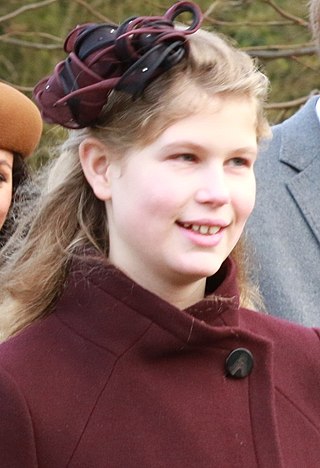
Lady Louise Alice Elizabeth Mary Mountbatten-Windsor is the daughter of Prince Edward, Duke of Edinburgh, and Sophie, Duchess of Edinburgh. She is a granddaughter of Queen Elizabeth II, and the youngest niece of King Charles III. Born 8th in line to the British throne, she is now 16th.

The Sword and the Rose is a family/adventure film produced by Perce Pearce and Walt Disney and directed by Ken Annakin. The film features the story of Mary Tudor, a younger sister of Henry VIII of England.
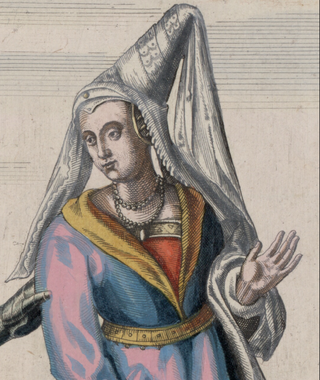
Judith of Flanders was a Carolingian princess who became Queen of Wessex by two successive marriages and later Countess of Flanders. Judith was the eldest child of the Carolingian emperor Charles the Bald and his first wife, Ermentrude of Orléans. In 856, she married Æthelwulf, King of Wessex. After her husband's death in 858, Judith married his son and successor, Æthelbald. King Ætheldbald died in 860. Both of Judith's first two marriages were childless. Her third marriage was to Baldwin I, Margrave of Flanders, with whom she had several children.
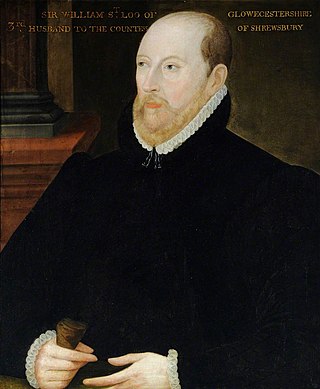
Matthew Stewart, 4th Earl of Lennox was a leader of the Catholic nobility in Scotland. He was the paternal grandfather of King James VI of Scotland. He owned Temple Newsam in Yorkshire, England.

Elizabeth: The Golden Age is a 2007 biographical historical drama film directed by Shekhar Kapur and produced by Universal Pictures and Working Title Films. It stars Cate Blanchett in the title role and is a loose but fact-based portrayal of events during the latter part of the reign of Elizabeth I, forming a sequel to Kapur's 1998 film Elizabeth. The film co-stars Geoffrey Rush, Clive Owen, Jordi Mollà, Abbie Cornish, and Samantha Morton. The screenplay was written by William Nicholson and Michael Hirst, and the music score was composed by Craig Armstrong and A. R. Rahman. Guy Hendrix Dyas was the film's production designer and co-visual effects supervisor, and the costumes were created by Alexandra Byrne. The film was shot at Shepperton Studios and various locations around the United Kingdom.

The Other Boleyn Girl (2001) is a historical novel written by British author Philippa Gregory, loosely based on the life of 16th-century aristocrat Mary Boleyn of whom little is known. Inspired by Mary's life story, Gregory depicts the annulment of one of the most significant royal marriages in English history and conveys the urgency of the need for a male heir to the throne. Much of the history is highly distorted in her account.

Christina of Denmark was a Danish princess, the younger surviving daughter of King Christian II of Denmark and Norway and Isabella of Austria. By her two marriages, she became Duchess of Milan, then Duchess of Lorraine. She served as the regent of Lorraine from 1545 to 1552 during the minority of her son. She was also a claimant to the thrones of Denmark, Norway and Sweden in 1561–1590 and was sovereign Lady of Tortona in 1578–1584.

Katherine Brandon, Duchess of Suffolk, suo jure12th Baroness Willoughby de Eresby, was an English noblewoman living at the courts of King Henry VIII, King Edward VI and Queen Elizabeth I. She was the fourth wife of Charles Brandon, 1st Duke of Suffolk, who acted as her legal guardian during his third marriage to Henry VIII's sister Mary. Her second husband was Richard Bertie, a member of her household. Following Charles Brandon's death in 1545, it was rumoured that King Henry had considered marrying Katherine as his seventh wife, while he was still married to his sixth wife, Catherine Parr, who was Katherine's close friend.

That Lady is a 1955 British-Spanish historical romantic drama film directed by Terence Young and produced by Sy Bartlett and Ray Kinnoch. It stars Olivia de Havilland, Gilbert Roland, and Paul Scofield.

With a Tangled Skein is a fantasy novel by Piers Anthony. It is the third of eight books in the Incarnations of Immortality series. In it, Niobe agrees to become one of the three aspects of the incarnation of Fate, in an attempt to thwart the plans of Satan.
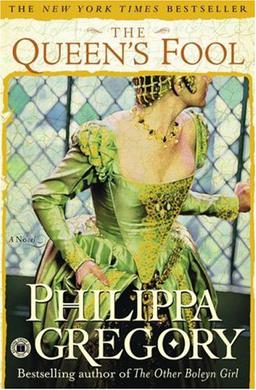
The Queen's Fool by Philippa Gregory is a 2003 historical fiction novel. Set between 1548 and 1558, it is part of Philippa Gregory's Tudor series. The series includes The Boleyn Inheritance. The novel chronicles the changing fortunes of Mary I of England and her half-sister Elizabeth through the eyes of the fictional Hannah Green, a Marrano girl escaping to England from Spain where her mother was burned at the stake for being Jewish. Hannah is discovered by Robert Dudley and John Dee and subsequently begged as a fool to Edward VI. She witnesses and becomes caught up the intrigues of the young king's court, and later those of his sisters. As Mary, Elizabeth, and Robert Dudley use Hannah to gather information on their rivals and further their own aims, the novel can plausibly present each side in the complex story. The Queen's Fool follows Hannah from ages fourteen to nineteen, and her coming-of-age is interspersed among the historical narrative. The book reached # 29 on the New York Times Best Seller list and had sold 165,000 copies within three weeks of its release.
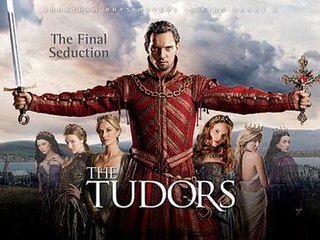
The Tudors is a historical fiction television series set primarily in 16th-century England, created and written by Michael Hirst and produced for the American premium cable television channel Showtime. The series was a collaboration among American, British, and Canadian producers, and was filmed mostly in Ireland. While named after the Tudor dynasty as a whole, it is based specifically upon the reign of King Henry VIII.

The White Queen is a 2009 historical novel by Philippa Gregory, the first of her series The Cousins' War. It tells the story of Elizabeth Woodville, queen consort of King Edward IV of England. The 2013 BBC One television series The White Queen is a 10-part adaptation of Gregory's novels The White Queen, The Red Queen (2010) and The Kingmaker's Daughter (2012), and features Rebecca Ferguson as Elizabeth Woodville.

Isabella of Portugal was the empress consort of her husband Charles V, Holy Roman Emperor, King of Spain, Archduke of Austria, and Duke of Burgundy. She was Queen of Spain and Germany, and Lady of the Netherlands from 10 March 1526 until her death in 1539, and became Holy Roman Empress and Queen of Italy in February 1530. She acted as regent of Spain during her husband's long absences.

Cordel Encantado is a Brazilian telenovela produced and broadcast by TV Globo from 11 April to 23 September 2011. It has been re-aired in Globo's Vale a Pena Ver de Novo since 14 January 2019.




















